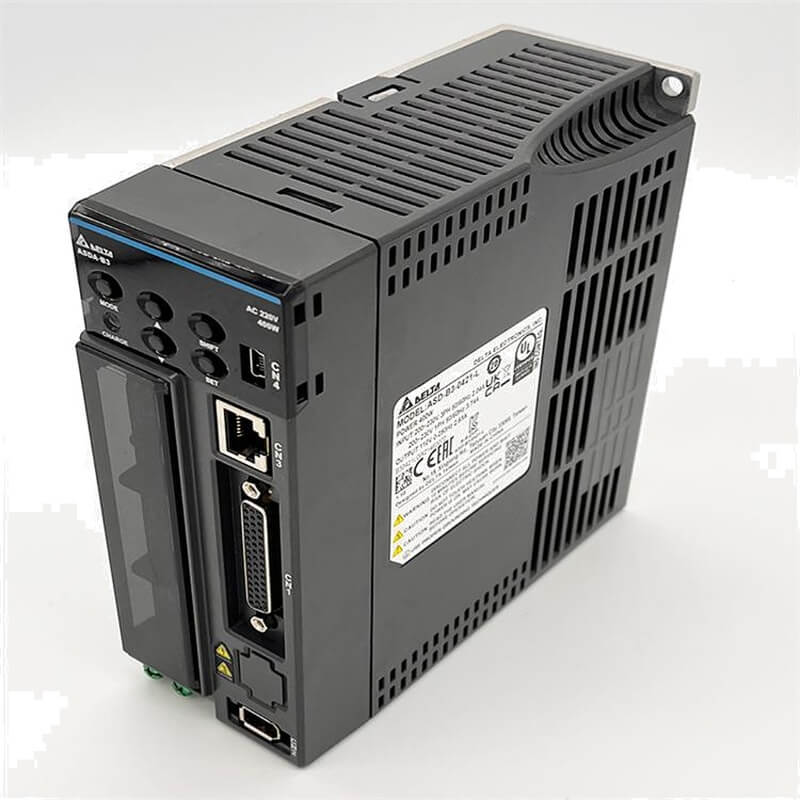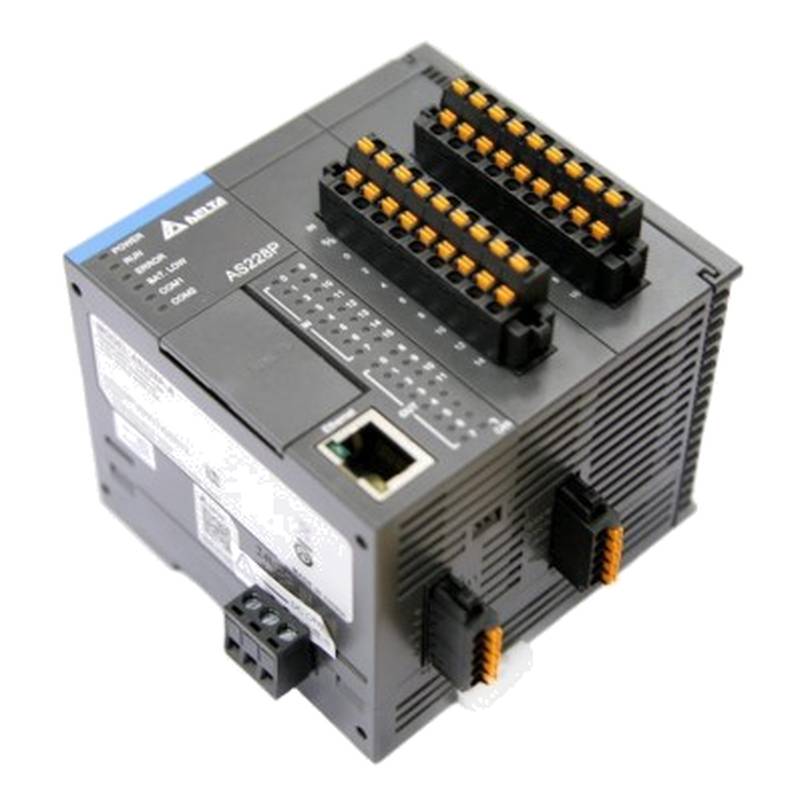
The Delta DVP08HN11R is a high-performance relay output module designed for robust AC load applications, offering superior reliability and flexibility in industrial automation. This module distinguishes itself with a compact form factor, a generous number of output points, and efficient heat dissipation, making it an ideal choice for demanding control environments. Its core advantages lie in its robust relay switching capabilities, straightforward integration, and compatibility with Delta's widely adopted DVP series Programmable Logic Controllers (PLCs). Key technical parameters include 8 relay output channels, a 250VAC/2A rated output, a 24VDC input voltage, and an operating temperature range of 0°C to 55°C.
Product Specifications
| Feature | Specification |
| :---------------------- | :--------------------------------------------- |
| Model | DVP08HN11R |
| Output Type | Relay Output |
| Number of Output Points | 8 |
| Rated Load | 250VAC / 2A, 30VDC / 2A |
| Input Voltage | 24 VDC |
| Isolation | Photocoupler isolation |
| Operating Temperature | 0°C to 55°C (32°F to 131°F) |
| Storage Temperature | -40°C to 60°C (-40°F to 140°F) |
| Ambient Humidity | 5% to 95% (non-condensing) |
| Vibration/Shock Resist. | Complies with IEC60068-2-6/IEC60068-2-27 |
| Dimensions (W x H x D) | 86mm x 90mm x 34.5mm |
| Mounting | DIN rail or screw mounting |
Core Features & Market Positioning
The Delta DVP08HN11R excels in the industrial automation market due to its inherent reliability and cost-effectiveness for AC load control. Its use of high-quality relays ensures a significant number of switching cycles, a critical factor for longevity in continuous operation scenarios. Unlike solid-state output modules, these relays offer complete electrical isolation, preventing backflow or interference between the controlled circuits and the PLC. This feature is paramount in environments with fluctuating power supplies or sensitive electronic components. Furthermore, its integration within the Delta DVP ecosystem simplifies system design and maintenance, as it seamlessly interfaces with other DVP series modules and PLCs, providing users with a cohesive and powerful automation solution.
Key Application Scenarios
This relay output module is ideally suited for a wide array of industrial applications where AC loads require direct switching. Common use cases include controlling solenoid valves in pneumatic or hydraulic systems, operating small motor starters for pumps or fans, and managing lighting circuits in factory settings. Its robust 2A rating per channel makes it versatile enough for managing actuators, heaters, and other moderate-power AC devices. Industries such as manufacturing, packaging, material handling, and building automation frequently leverage the DVP08HN11R for its dependable performance in discrete control tasks.
Practical System Integration Guidance
Integrating the Delta DVP08HN11R into an automation system is straightforward. The module typically mounts onto a standard 35mm DIN rail or can be secured via screws. Wiring involves connecting the 24VDC power supply to the module's power terminals and then connecting the field devices (e.g., solenoids, contactors) to the individual relay output terminals. For programming, users will utilize the Delta ISPSoft software, mapping the physical output points to specific bits or coils within the PLC's program. For instance, to activate an AC motor controlled by an external contactor, a specific output coil in the PLC program would be assigned to the DVP08HN11R's output channel, and when that coil is energized, the corresponding relay contacts close, energizing the contactor coil.
Operation and Risk Mitigation
Proper operation of the DVP08HN11R involves ensuring that the connected AC loads do not exceed the module's rated capacity of 2A at 250VAC. Overloading the relay contacts can lead to premature failure, contact welding, or even fire hazards. It is crucial to verify that the input voltage supplied to the module is stable at 24VDC ±10%. Transient voltage spikes on the DC power supply can cause erratic module behavior or damage. In terms of troubleshooting, common issues often stem from incorrect wiring, exceeding load limits, or environmental factors like excessive dust or moisture. Always ensure proper grounding of the system to mitigate electrical noise and potential shock hazards.
Scalability & Long-Term Value
The Delta DVP08HN11R offers significant scalability and long-term value, particularly when integrated with Delta's DVP series PLCs. These PLCs are known for their modularity, allowing users to easily expand their I/O count by adding more DVP series modules, including additional relay or transistor output modules, as system requirements grow. This backward compatibility ensures that investments in Delta automation hardware remain relevant over time. Furthermore, Delta's commitment to IIoT (Industrial Internet of Things) and smart manufacturing solutions means that systems built with DVP components can be readily integrated with SCADA systems, MES (Manufacturing Execution Systems), and cloud-based data acquisition platforms, providing enhanced analytics, remote monitoring, and predictive maintenance capabilities.
Frequently Asked Questions (FAQs)
What is the maximum AC voltage the Delta DVP08HN11R can switch?
The Delta DVP08HN11R relay output module is rated for a maximum AC voltage of 250VAC. This specification ensures it can safely handle common industrial AC power requirements for various control devices. Exceeding this voltage limit can cause insulation breakdown and permanent damage to the relay contacts.
This rating allows for reliable operation with a wide range of AC-powered equipment found in factory automation and control systems. Users must always confirm their load voltage aligns with this parameter to ensure safe and efficient operation.
Adhering to this voltage limit is crucial for maintaining the longevity of the module and preventing potential safety hazards or equipment failures within the control system.
Can the DVP08HN11R be used for DC loads?
Yes, the Delta DVP08HN11R can be used for DC loads, with a maximum rating of 30VDC at 2A. While primarily designed for AC applications, its relay contacts are versatile enough to handle DC switching within specified limits. This dual capability enhances its applicability across diverse industrial scenarios where both AC and DC control signals are present.
When switching DC loads, it's important to be aware that DC arcs can be more persistent than AC arcs due to the absence of zero-crossing points. This may slightly affect contact life compared to AC usage, although the 2A rating provides a good margin for many common DC applications.
Always ensure the DC voltage and current do not exceed the 30VDC/2A specification to prevent contact damage or premature wear, maintaining the module's reliability for your specific application.
How do I wire the Delta DVP08HN11R for a simple motor control circuit?
For simple motor control, wire the 24VDC power supply to the module's power input terminals. Then, connect the common terminal of a relay output channel to one side of your motor starter's coil. Connect the normally open (NO) contact of that same relay output channel to the other side of the motor starter's coil. The PLC program then energizes this output channel to activate the motor starter.
Ensure that the motor starter's coil voltage matches the relay output capabilities and that the current drawn by the starter coil does not exceed the DVP08HN11R's 2A rating. Proper wiring prevents short circuits and ensures the starter coil receives sufficient power to engage.
Always refer to the detailed wiring diagrams in the DVP08HN11R manual for correct terminal identification and connection sequences. This minimizes installation errors and ensures the safety and functionality of your motor control system.






















